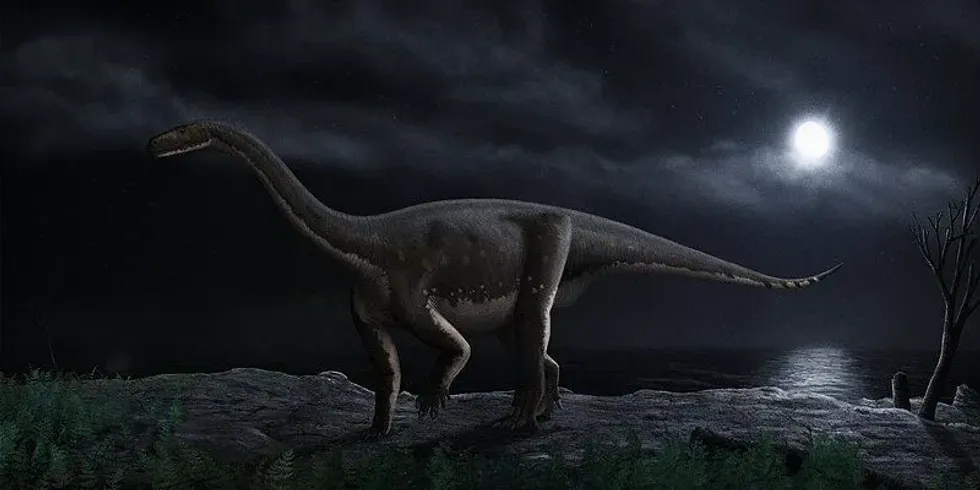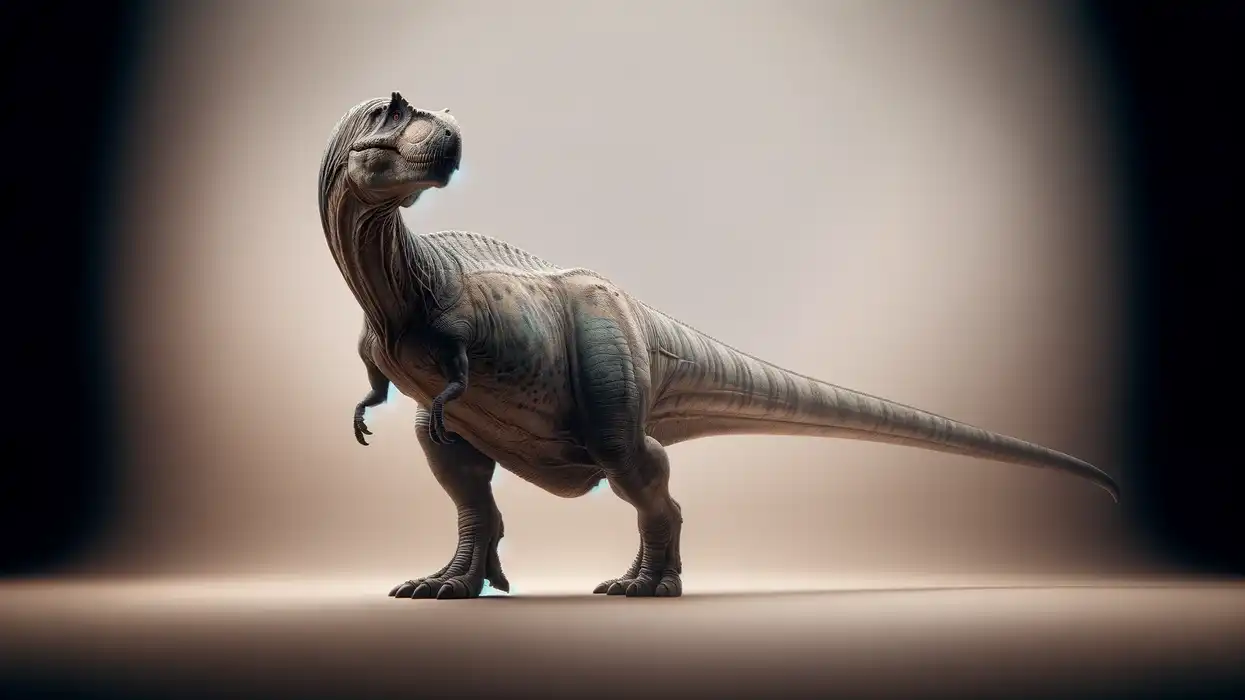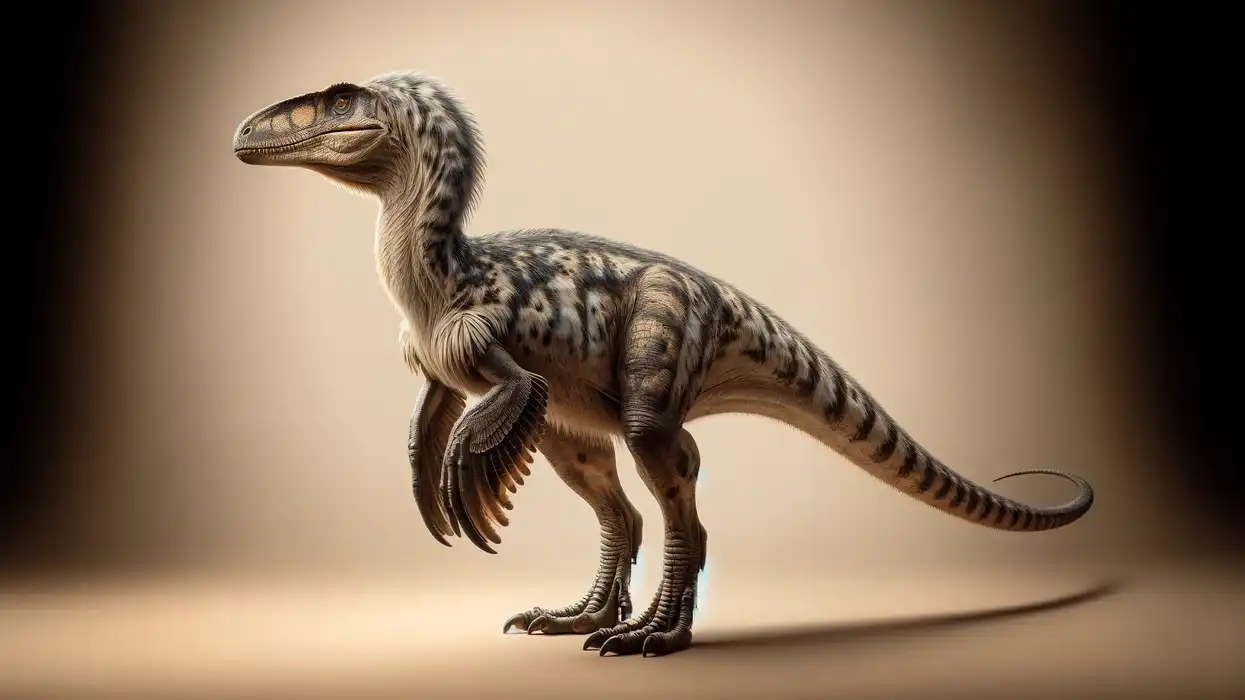The Triassic dinosaur, Melanorosaurus (Haughton, 1924) is also known as the 'black mountain lizard'. The dinosaur fossil was found on the slope of Thaba 'Nyama in South Africa; the name of the mountain means 'black mountain'. This dinosaur genus lived during the Triassic-Jurassic period.
Its classification description is Dinosauria, Saurischia, Sauropodomorph, Prosauropoda, Anchisauria, and Melanorosauridae genus. The dinosaur was quadrupedal and had a heavy and large body with short stout limbs, an elongated flexible tail, and a triangular skull. It reproduced by laying eggs.
If you like reading about the Melanorosaurus dinosaur, also check out interesting dinosaur facts about Dryosaurus and Gasparinisaura.
Melanorosaurus Interesting Facts
How do you pronounce 'Melanorosaurus '?
The name Melanorosaurus is pronounced 'me-lan-or-oh-sore-us'.
What type of dinosaur was a Melanorosaurus?
The Melanorosaurus dinosaur of phylum Chordata is a genus of basal sauropodomorph dinosaurs.
In which geological period did the Melanorosaurus roam the Earth?
The Melanorosaurus lived during the Late Triassic period, 200-230 million years ago. The Late Triassic period was also called the Upper Triassic period.
When did they become extinct?
Melanorosaurus dinosaurs went extinct around 200 million years ago. They are one of the oldest dinosaurs that have been found. It went extinct before the more commonly known Jurassic period.
Where did a Melanorosaurus live?
Annals of the South African Museum show that the Melanorosaurus dinosaur fossil was found in South Africa in the Upper Triassic Lower Elliot Formation and Upper Elliot Formation geological landscape. It was found in Transkei (South Africa) on the slopes of Thaba 'Nyama meaning 'black mountain' which makes it endemic to present-day South Africa.
What was a Melanorosaurus's habitat?
The climate during the Triassic period is described as warm and dry with seasonal rains in some areas. The Melanorosaurus did not live near water. This dinosaur lived in rocky areas with enough vegetation to provide for its herbivorous diet.
Who did a Melanorosaurus live with?
The Melanorosaurus was a typical early sauropod quadrupedal dinosaur that lived as a member of herds or groups with its conspecifics. The juveniles of any dinosaur species usually congregate to form groups, but in the case of this Sauropodomorpha Dinosauria clade of dinosaurs, the adults also formed herds.
How long did a Melanorosaurus live?
The exact lifespan of a Micropachycephalosaurus is not known. Very little information is available regarding their lifespan or life cycle at the moment. However, like most dinosaurs they might have large physical changes taking place as they move through the different life stages; juvenile, sub-adult, and adult.
How did they reproduce?
Very little information is available on the subject of Melanorosaurus reproduction. It is assumed that they had a particular breeding season and like other dinosaurs and reptiles laid eggs. Internal fertilization took place after which the eggs were laid by the female. The juvenile horned dinosaurs hatched from the eggs.
Melanorosaurus Fun Facts
What did a Melanorosaurus look like?

The Melanorosaurus was one of the largest dinosaurs and terrestrial creatures ever known, including modern-day animals. The older sauropod dinosaurs of the Triassic period like the Melanorosaurus had a long neck but it was still shorter than the necks of sauropod dinosaurs from the later geological periods.
It had an elongated body and tail, the latter of which was flexible and tapered towards the end. Its main function was to maintain a good balance. The Melanorosaurus femur was straight and thick.
The Melanorosaurus skull was triangular and about 9 in (22.86 cm) long. The Melanorosaurus had a hip bone similar to a lizard and is a Dinosauria Saurischia classification. The jawbone of this dinosaur has 38 teeth, 19 on each side.
It had a beak-like nose. Like the majority of dinosaurs, it was a quadrupedal dinosaur, with strong, stout early sauropod limbs which supported its entire body weight.
How many bones did a Melanorosaurus have?
The exact number of bones in the Melanorosaurus or 'Black Mountain Lizard' is not known since a complete skeletal fossil is yet to be found in South Africa. The postcranial anatomy of referred specimens of the Melanorosaurus was conducted on its femur, skull, and other bone fossils by Van Heerden.
How did they communicate?
Like other dinosaurs, it can be assumed that the Melanorosaurus dinosaur communicated using their large bodies and vocalization. Dinosaurs created distinct open-mouthed sounds and closed-mouthed sounds. The close-mouthed sounds of a lower frequency could travel long distances, which helped them communicate with the rest of the herd or warn rivals of their territory.
How big was a Melanorosaurus?
The Melanorosaurus is one of the largest terrestrial animals ever known. This Norian Triassic dinosaur description length is 30-40 ft (9.14-12.19 m) long and 12 ft (3.65 m) tall. It wass five times larger than a Sumatran elephant and 10-12 times larger than a woolly mammoth.
How fast could a Melanorosaurus move?
Considering its large size the Melanorosaurus probably couldn't move very fast. Its exact speed is not known. Dinosaur speeds are estimated using their fossilized footprints which are found under layers of the earth after excavation.
How much did a Melanorosaurus weigh?
Not surprisingly, the Melanorosaurus weighed around 1.3 tonnes (1179.34 kg). It's five times heavier than a hippo and 200 times heavier than a Sumatran rhinoceros.
What were the male and female names of the species?
The large Melanorosaurus sauropodomorphs don't have any sex-specific names for the male and female of the species. While many dinosaurs exhibited sexual dimorphism, it remains unclear whether the Melanorosaurus did. Sexual dimorphism usually helps in distinguishing between the sexes.
What would you call a baby Melanorosaurus?
The baby Melanorosauruses have no particular name either. The baby can be called a juvenile.
What did they eat?
The Melanorosaurus Sauropodomorpha dinosaur species was considered to be a herbivore. It fed on plants, fruits, and leaves. Recent evidence conducted around the teeth of the dinosaur shows that they also may have eaten meat. Thus they can be considered omnivorous dinosaurs.
How aggressive were they?
Very little information is available regarding the behavioral habit description of the sauropodomorph, Melanorosaurus. Considering they were herbivores or omnivores, they were not thought to be aggressive. They usually didn't harm other dinosaurs and since they were very big, they didn't need to run or protect themselves from other dinosaurs.
Did you know...
The Norian Melanorosaurus thabanensis species was named by Gauffre (1993), based on a femur specimen, MNHN LES-16, which was found in the Upper Triassic lower Elliot Formation. Recently, it was discovered that the femur and six other bones do not belong to the Melanorosaurus genus, and thus a new combination of Meroktenos thabanensis (Gauffre) was created for the specimen.
The description of the first complete skull of the Triassic dinosaur referred to as 'Melanorosaurus specimen NM QR3314' was in 2007. It was found in the Upper Elliot Formation.
The Melanorosaurus lived through the Triassic-Jurassic extinction event. Dinosaurs from the Jurassic period are more popularly known today. It is one of the few animals that have lived in the Triassic period as well as the Jurassic stage.
What caused the Cretaceous extinction?
The Cretaceous–Paleogene also known as K–Pg extinction event was a sudden mass extinction of 75% of terrestrial plant and animal species on Earth, around 66 million years ago.
Except for some species like sea turtles and crocodilians, animals weighing more than 55 lb (25 kg) did not survive. It resulted in the evolution of avian dinosaur species which are thought to have become modern-day birds and fowls.
This mass extinction event marked the end of the Cretaceous time period, along with the Mesozoic Era, and the beginning of the Cenozoic Era, which continues to this day in the world.
The Cretaceous–Paleogene mass extinction is said to have been caused 66 million years ago by the impact of a massive comet or asteroid which was 6-9 mi (9.6-14.48 km) wide. This comet or asteroid devastated the global environment of that time irreversibly.
It caused a lingering impact in winter that halted photosynthesis in plants and plankton, a process essential for the production of oxygen. The radiation forced the evolution of the species which still lived after the extinction event.
According to geological evidence, the Cretaceous–Paleogene mass extinction event is marked by thin layered sediment in the crust known as the K–Pg boundary. It is found throughout the world in both marine, and terrestrial rocks.
The boundary layer in the rocks shows an unusually high level of the metal iridium, which is commonly found in large quantities in asteroids rather than in the Earth's crust. This layer has up to 1000 times more iridium than other solid layers in the crust.
Was Melanorosaurus a sauropod?
The Melanorosaurus was initially placed under the classification as Prosauropoda, but Prosauropoda is no longer considered as a natural group. Instead, the Meanorosaurus is now considered an early Sauropod because it fits this definition better.
But since this definition of Sauropod described several other Prosauropod dinosaurs, a new definition of Sauropoda was proposed which excludes the Melanorosaurus as sauropodomorphs. Its final classification is currently Dinosauria, Saurischia, Sauropodomorph, Prosauropoda, Anchisauria, Melanorosauridae.
Here at Kidadl, we have carefully created lots of interesting family-friendly dinosaur facts for everyone to discover! Learn more about some other dinosaurs from our Archaeoceratops facts and Pegomastax fun facts pages.
You can even occupy yourself at home by coloring in one of our free printable Melanorosaurus coloring pages.
First image by Steve Oc.
Second image by Mario Lanzas.









